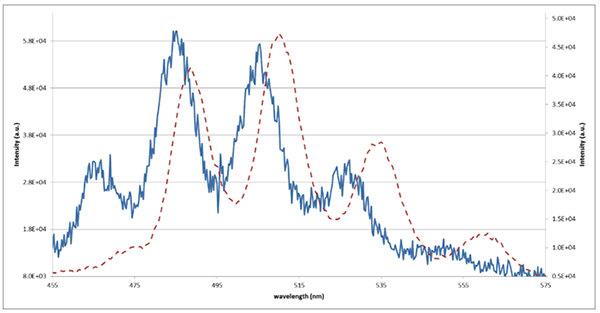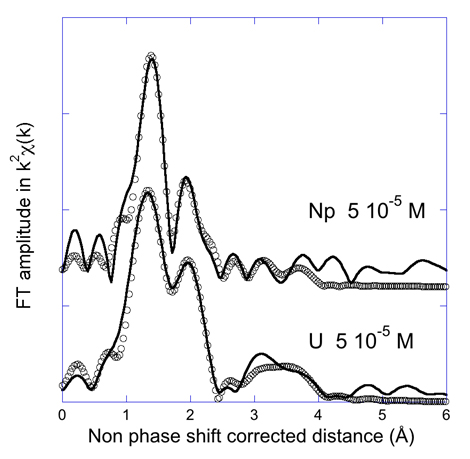What becomes of natural radionuclides or those resulting from nuclear activity in the environment? The question is all the more crucial following the recent events in Fukushima, given its location by the sea, as studies on the subject are rare. A research group from the Nice Chemistry Institute (CNRS / University of Nice) and CEA DAM became interested in the speciation of uranium and neptunium in sea water, in order to understand the mechanisms at work but also to assess their impact. Their work has been published in the Royal Society of Chemistry Dalton transactions.
The environmental fate of natural and anthropogenic radionuclides resulting from nuclear activity remains a major concern in today's society. Military nuclear tests dating from the cold war period, as well as civil nuclear accidents, have led to the significant release of radionuclides into the environment and under different forms. The most recent major event at Fukushima in 2011, for example, impacted more specifically the marine environment, due to the location of the plant. Furthermore, as the oceans cover three quarters of the globe and are home to many exchanges within the hydrosphere, the study of the behavior of radionuclides in this environment, i.e. their speciation, is essential. There are, however, still very few studies on the marine environment and data on the molecular scale are practically non-existent. This may be partly due to the complexity of this medium, where very high salinity is one of the key features. It is therefore essential to acquire greater knowledge of the speciation of these elements in sea water in order to understand the various transfer mechanisms, but also to assess their impact.
The aim of these scientists was to study the speciation of uranium (VI), as well as that of neptunium (V) in sea water. The "natural" concentration of radionuclides and, in particular, actinides, is extremely low in sea water (10-8 M in the case of uranium and < 10-13 M for other actinides). While spectrometric methods such as inductively coupled plasma-mass spectrometry (ICP-MS) or accelerator mass spectrometry (AMS) provide measurements of the order of parts per trillion (ppt), spectroscopic techniques giving access to molecular speciation do not provide such sensitivity. To work around this problem while remaining as representative as possible of the natural environment, the group worked on natural seawater solutions doped with 5.10-5 M actinides.
First, the speciation of uranium and neptunium was modeled with known complexation constants listed in databases. These data were then compared with the results obtained experimentally using the combination, in the case of uranium, of EXAFS (Extended X-ray Absorption Fine Structure) and TRLIF (Time Resolved Laser-Induced Fluorescence) spectroscopies. For neptunium, however, only EXAFS could be used, as this element is not fluorescent under these conditions.

Figure 1 : TRLIF spectra of uranium: standard solution of uranium (VI) representing an aquo ion (- -) (pH 1) and seawater solution doped with 5.10-5 M (¾) pH 8.
For uranium, TRLIF helped demonstrate the major presence of the neutral complex Ca2UO2(CO3)3 in seawater at 5.10-5 to 1.10-5 M (Figure 1). EXAFS measurements were made on the MARS beamline, dedicated to the study of radioactive materials at the SOLEIL synchrotron (Figure 2). Adjustments to the EXAFS spectrum showed that the uranium is bound to three carbonate groups. The average distances obtained are 1.80 Å between the uranium atom and axial oxygen, 2.43 Å between uranium and equatorial oxygen and 2.90 Å between uranium and the carbons. These distances are characteristic of bidentate carbonate groups. With neptunium, it was more difficult to record EXAFS spectra because of the presence of bromine in seawater (for which one of the fluorescence emission lines is very close to the LIII line of interest for neptunium),thus disrupting the signal to noise ratio. Nevertheless, EXAFS data did indicate the presence of at least one carbonate ligand with a distance of 2.54 Å between the neptunium atom of and the equatorial oxygens and a distance of 2.99 Å with the carbon. The uncertainty in the number of carbons is very high, thus making it difficult to conclude on the number of carbonate ligands. By linking these data with theoretical speciation it appears that the neptunium (V) is present in two forms in seawater: NpO2+ and NpO2CO3-.

Figure 2 : Fourier transform of the EXAFS experimental (¾) and adjusted (ooooo) spectra of sea water solutions doped with uranium and neptunium at 5.10-5 M LIII threshold of uranium and LII of neptunium.
In the case of uranium, the Ca2UO2(CO3)3 complex was found to be non-toxic or non-bioavailable. This study shows that knowledge of the speciation of actinides in the marine environment is complex and requires the coupling of spectroscopic techniques with modeling. In the particular case of seawater, the impact on speciation of the presence of high concentrations of certain cations (Ca2+, Na+, etc.) is not insignificant.
